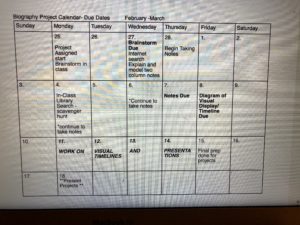This post is part of a series about helping students with LBLD experience academic success.
Read Lauren’s other blog posts:
As teachers, we have all been faced with the challenge of engaging our learners in shared research. This activity has always been challenging for me: what will my students get out of the project, who is doing the actual research, and what the end result will look like?
Again, I have really shifted my way of thinking about research based classroom projects and have come to realize from my Landmark Outreach training that it is not all about the final end result of the project. My students don’t need to have the most attractive project, but rather it is the ability to engage in the learning process and study skills that are most beneficial to our language-based learners. If we don’t spend the time breaking down the tasks that are involved in a research project and explicitly teaching these tasks to our youngest learners, then they will struggle and their projects will become overwhelming.
Break down the process
It can be easy to make assumptions about student background knowledge, especially in the area of research. As educators, we need to take a step back and look at all of necessary skills that each child needs to have in place in order to complete a research project independently. For example, in the past I taught a unit on the solar system in an inclusion science class. At the end of the unit, we asked the students to work in small groups to research one aspect of the solar system and present a powerpoint project to the class. The assignment sounds clear, but think about all the skills a child must have in order to successfully complete that task. Students must be able to:
- Organize information/manage time and due dates
- Read and locate information
- Use a library
- Search the internet
- Categorize
- Take notes
- Summarize
- Determine main ideas and details
- Work with a group
- Delegate tasks within a group
- Find reliable resources
- Use PowerPoint
- Implement writing skills
- Use typing skills
- Create a bibliography
We have to take a look at our own teaching to make sure we teach all of these skills to our students before and/or during the research process. We can’t expect that they will just magically know how to do many of these steps without explicit instruction and reminders.
This school year, I was able to create a long term biography research project for my students; they created a timeline of a famous person’s life. My big shift in thinking was that I was going to use this research project to begin to teach students how to locate information in the library, from both books and from the internet. I honestly didn’t get hung up on what the timeline project looked like in the end – I was just determined to teach everyone how to locate information. Once I had a clear focus and goal in mind, I was able to feel good about the work we were doing and not get overwhelmed with the task. We had so much fun as a class learning how to find books in the library on our topic. We worked hard on understanding nonfiction textbooks and how to use a table of contents, glossary, and index to help us locate information. I also researched reliable websites, such as PebbleGo, where students could listen to information read out loud to them. We used a timeline, two-column notes, and a timeline presentation layout to organize information (see templates).
Things to consider when creating a long-term research project:
- Focus/Goal: What do I want the end result to look like? Is it written or an oral presentation? Is it a project for the whole group, small groups, or individual students? It is important to make time to model the process with a whole group project first so they will understand exactly what to do when working on their own independently.
- Skills: Take inventory of which skills you have already taught and which skills you need to explicitly teach during the project.
 Structure: Give all students due dates to help them with long range planning by creating calendars. This will not only help you stay on track, it will help the students begin to see the steps needed to complete a research project. Also, use templates for note taking and and for the presentation layout – this is a game changer. Have students physically show you what information will go where on the project. For example, if it is a PowerPoint project, have them lay out the slides on paper first before they can move to creating them on the computer.
Structure: Give all students due dates to help them with long range planning by creating calendars. This will not only help you stay on track, it will help the students begin to see the steps needed to complete a research project. Also, use templates for note taking and and for the presentation layout – this is a game changer. Have students physically show you what information will go where on the project. For example, if it is a PowerPoint project, have them lay out the slides on paper first before they can move to creating them on the computer.
For my students who have much difficulty understanding nonfiction texts, this biography project truly allowed them to feel successful. Each child was able to create his/her timeline independently and stand up in front of the class to share their information confidently. By taking the time to set them up for success by scaffolding the tasks of a research project, they were able to demonstrate a clear understanding of the person they researched.



